|
|
|
|
|
|
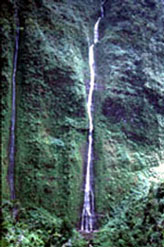 |
|
Before the arrival of Europeans,
water was controlled by the konohiki (manager) as part
of the ahupua'a system. Water was sacred. It was a gift from
Kane i ka wai ola (Procreator in the water of life),
and delivered by Lono makua (the Rain Provider). How
was wai managed and sustained in the ahupua'a of Nawiliwili
Bay? |
|
|
|
Water relies
extensively on Native Planters in Old Hawaii by E.S.
Craighill Handy and Elizazbeth Green Handy for information about
the traditional Hawaiian use of water. |
|
|
|
|
To the farmer, wai was life, wai was wealth,
wai was the source of the law of the land. Wai
was needed to grow kalo, the principal food resource.
The right to use wai depended on the use of it. As
long as the maka'ainana cultivated the land and contributed
their share of labor required to maintain the water resource,
they had a right to use the water for their kalo.
(Handy and Handy)
|
|
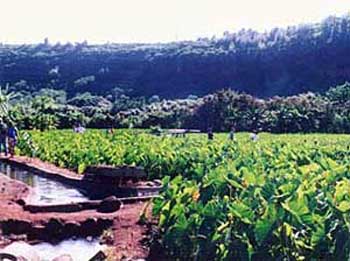 |
|
|
|
Photo by Chris Faye
|
|
|
|
|
|
|
|
|
|
|
|
|
|
|
Kalo lo'i alone could claim
the water. Other plants were considered dry land crops, unless
there was water to spare. People worked together to build and
maintain lo'i (taro fields) and 'auwai (irrigation
canals) in each of the ahupua'a of Nawiliwili Bay.(Handy and
Handy) |
|
|
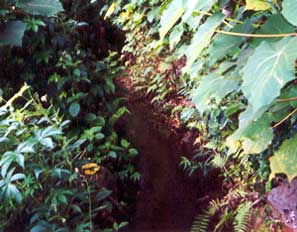 |
|
Kalo cannot grow in stagnant water. It needs a constant
supply of cool water flowing through it.. Although planters
diverted water from the stream into an 'auwai to deliver
this water to the lo'i, the
total amount taken was never more that 50% of the total flow.
Once used in the lo'i, the water was returned to the
stream. Pani wai (dams) were used to divert the stream
into the 'auwai. (Handy and Handy) To the left, a traditional
'auwai in Hule'ia with modern weeds. |
|
| These pani wai
were built by stacking basalt boulders across a stream. This
did not change the stream bottom and stream width, or block
the passage of native stream animals from mauka to
makai. Groups sharing the pani wai killed anyone
who broke it, cramming the dead body into the break. Water was
extremely serious to the native planter. (Handy and Handy) |
|
|
|
|
|
Pani wai on Hule'ia Stream
|
|
|
|
|
|
|
Mirrored pondfields in Nawiliwili
Valley
Photo courtesy of the Kaua'i Historical Society
|
|
The five stream valleys at Nawiliwili Bay would have been ideal
for kalo. It is reported that kalo was grown all
the way up the Nawiliwili River valley, up to half a mile above
the mill.
(Handy and Handy) |
|
|
Taro was grown all the way up the Nawiliwili Stream to half
a mile above the mill. |
|
|
|
|
|
|
Taro patches near Lihue, Kaua'i, Hawai'i,
ca. 1886.
Photographer: Alfred Mitchell.
Photo courtesy of the Bishop Museum.
|
|
|
|
|
Pu'ali Taro at the mouth of
Pu'ali Stream in 1905
Photo courtesy of the Kaua'i Historical Society
|
|
|
Kalo was planted at the seaward end
of Pu'ali and Halehaka streams.
(Handy and Handy)
|
|
|
|
|
|
Kalapaki kalo
|
|
Kalo was grown in the streams,
valleys, and springs of Kalapaki. Above, lo'i are visible
in the valley behind the houses. The hill along the ocean was
leveled and used to fill in this valley for the present hotel
(Hobey Goodale) |
|
|
|
 |
|
|
Above, pond fields and fish ponds on the
Niumalu Flats. Truly a wet land.
Photo courtesy of the Kaua'i Historical Society
|
|
|
The Hule'ia river valley was
ideal for lo'i, with terraces up the river to Kipu
Falls, and terraces up the streams that emptied into the
Hule'ia. (Handy and Handy) |
|
|
|
|
|
Another use of
wai was for aquaculture. The invention of the loko
‘ia (fishpond) was a special achievement of the
Hawaiians. Fishponds were highly productive and developed
during the growth and expansion of the population. (Kirch)
Historian Samuel Kamakau said those who had fishponds
“loved the lands where they dwelt... Fishponds were
things that beautified the land, and a land with many
fishponds was called fat."
|
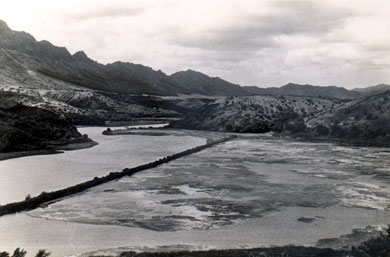 |
|
|
|
Alekoko Fishpond - still
in use in 1934, with awa, 'anae, and Samoan crab
(Hobey Goodale)
Photo courtesy of the Kaua'i Historical Society
|
|
|
|
|
|
Menehune Pond near Nawiliwili,
Kaua'i, Hawai'i, ca.1912.
Photographer: Ray Jerome Baker.
Photo courtesy of the Bishop Museum.
|
|
|
|
Let's visit Alekoko fishpond
in the 1930's with Hobey:
"One of my Japanese friends'
father was a good friend of the caretaker at the fishpond.
So the kaku, the barracuda, was giving him a bad
time, you know, they eating all the small mullet, so they
said, 'hey, what you boys want to do, you come up?' So
we started out going. There were five of us. We started
from Kalapaki, rowboat----rowed up to the fishpond and
the old man came out, 'Oh, you guys gonna catch kaku.
Good.' He said, 'you can throw your crab net in the river.'
In the river was kapu, too, see, for everybody, konohiki,
yeah? So he said, 'You guys can catch--put your crab net
in the river, but don't-no catch the crab in the pond.'
So, 'ok, ok.' And oh, those kids then oh, then nice big
crabs, we catch em but he don't know. He gives us a chance,
so we caught about three or four pretty good size crabs.
And we caught about 8 or 10 kaku--one was almost
five pounds, the damned kaku.
Oh, the old man was happy, and then he said,' wait, wait,
wait, wait.' He came out to tell us it's two o'clock so
you guys better go home. You have a long ways, against
the wind and everything. So before we got going, he said,
'Let me see your crab. Did you catch any crab?' We said,
yeah, and we showed him. He said, 'Oh, that's good. River
crabs.' I didn't know what he meant. And he said, 'Wait.'
And he went in with a scoop net in the pond by the gate--outlet--scooped
two huge crabs and tied em all up so they couldn't bite
em and everything and he said, 'OK, Hobey. You take em,
you're my neighbor.' [laughs] 'Hobey, you take 'em home
for your grandmother.' He knows where the hell we came
from, you know. And, uh--oh, big. And we looked at those
crabs. They're almost as blue like your shirt and the
ones from the river were red and brown from mud, uh? I
told the boys, I said, 'See. If we'd taken one of the
pond crabs, he would have caught us right away.'
" |
|
|
|
|
Kaua’i had 65 recorded
fishponds, with at least 9 on the Hule’ia river. The main
species of fish raised in ponds were awa (milkfish) and
anae (mullet). It was not unusual for a taro farmer to
cultivate o’opu and opae in his loko ‘ia
kalo. (Wichman) |
|
|
"'Ala
ke kai o ka 'anae"
Fragrant
is the soup of a big mullet.
A well to do person
is attractive because of his prosperity. A fat mullet
was well liked for broth.
Olelo Noeau # 106
|
|
|
|
|
 |
|
|
Ki'o Wai
Photo courtesy of the Kaua'i Historical Society
|
|
|
Looking out to sea across the west
side of Niumalu, we see the pond known as ki'o-wai (fresh
water pond). A kio was a small pond used for stocking
fish, usually attached to larger ponds. On the south side of
Hule'ia was the fishpond known as ka ipo li'a (amorous
sweetheart). Pepeawa was another large fish pond used
as a boundary for Niumalu. (Frederick B. Wichman) |
|
|
Tradition associates the most famous loko ‘ia, Alekoko
Fishpond, with two ali’i, a brother and a sister.
These fishponds were symbols of chiefly status and power, and
usually under the direct control of ali’i or konohiki.
The fish from these ponds often went to feed chiefly households.
(Handy and Handy) |
|
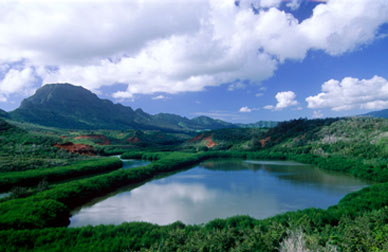 |
|
|
|
|
|
Alekoko today, plagued by
the mangrove.
Photo by David Boynton
|
|
|
|
|
|
|
|
|
|
Water and fertile land were plentiful
in the ahupua'a of Nawiliwili Bay. What were the qualities of
ahupua'a land management that protected the
sustainability of these resource? |
|
|
|
|
|
|
|
|
|
|
Created June 2001
|
|

